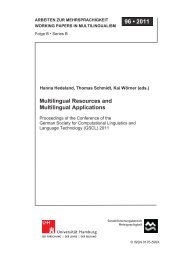Best Practices for Speech Corpora in Linguistic Research Workshop ...
Best Practices for Speech Corpora in Linguistic Research Workshop ...
Best Practices for Speech Corpora in Linguistic Research Workshop ...
You also want an ePaper? Increase the reach of your titles
YUMPU automatically turns print PDFs into web optimized ePapers that Google loves.
French and Russian screen versions of “Anna Karen<strong>in</strong>a”,<br />
British and Russian screen versions of “Sherlock<br />
Holmes”, and so on).<br />
This zone of the MultiPARC is <strong>in</strong>tended <strong>for</strong> the<br />
<strong>in</strong>vestigation <strong>in</strong> two fields: 1) comparable types of<br />
pronunciation (pauses, <strong>in</strong>tonation patterns, special<br />
phonetic features, like syllabification, chant<strong>in</strong>g, and so<br />
on), which are often the same <strong>in</strong> different languages, 2)<br />
comparable researches <strong>in</strong> gesticulation, which has its<br />
specificity <strong>in</strong> different cultures. We th<strong>in</strong>k that this zone of<br />
the MultiPARC may become the subject of <strong>in</strong>ternational<br />
cooperation.<br />
3. MultiPARC <strong>in</strong>terface<br />
The MultiPARC <strong>in</strong> total is supposed to have the <strong>in</strong>terface,<br />
which is adopted just now <strong>for</strong> the MURCO. The user’s<br />
query will return to a user a set of clixts, i.e. a set of the<br />
pairs ‘clip + correspond<strong>in</strong>g text’, the correspond<strong>in</strong>g texts<br />
be<strong>in</strong>g richly annotated. But the MultiPARC seems to have<br />
some specific features. The <strong>in</strong>vestigation of movie and<br />
theatrical speech has shown that the actors regularly<br />
trans<strong>for</strong>m the orig<strong>in</strong>al texts of a play (see [Grish<strong>in</strong>a 2007]).<br />
We often meet the trans<strong>for</strong>mations of the follow<strong>in</strong>g types:<br />
1) additions<br />
2) omissions<br />
3) shifts and transpositions<br />
4) synonymic equivalents<br />
5) apocopes<br />
6) restructur<strong>in</strong>g, and some others.<br />
(It should be noted parenthetically that these l<strong>in</strong>guistic<br />
events take place also <strong>in</strong> poetry, though quite rarely.)<br />
As a result, the real cue pronounced on the stage or on the<br />
screen may differ considerably from the correspond<strong>in</strong>g<br />
cue <strong>in</strong> the prototypical text. Consequently, the<br />
MultiPARC <strong>in</strong>terface ought to provide two types of<br />
queries: 1) query <strong>for</strong> the prototypical cue, 2) query <strong>for</strong> the<br />
real cue (see Pic. 1).<br />
If a user makes a query, which refers to the prototypical<br />
cue, then he/she receives the clusters of the real cues (i.e.<br />
the complete set of the clixts, which correspond to this<br />
very prototypical cue). But if a user makes a query, which<br />
refers to the unit (word, construction, comb<strong>in</strong>ation of<br />
letters, accent, and so on) <strong>in</strong>cluded <strong>in</strong> a real cue, but<br />
miss<strong>in</strong>g <strong>in</strong> the prototypical one, then he/she receives <strong>in</strong><br />
return only the real cues, which conta<strong>in</strong> this unit.<br />
4. Types of Annotation<br />
S<strong>in</strong>ce the MultiPARC is the result of further development<br />
of MURCO, it is quite natural that it will be annotated<br />
under the MURCO standards. These are as follows:<br />
• metatextual annotation<br />
• morphological annotation<br />
• semantic annotation<br />
• accentological annotation<br />
• sociological annotation<br />
• orthoepic annotation<br />
• annotation of the vocalic word structure<br />
We have described all types of MURCO annotation earlier<br />
([Grish<strong>in</strong>a 2010]), so we need not to return to the question.<br />
14<br />
5. MultiPARC as Scientific Resource<br />
MultiPARC is meant to be one of the resources <strong>for</strong> scientific<br />
researches, so its ma<strong>in</strong> task is the academic one. Be<strong>in</strong>g the<br />
academic resource, it lets us put and solve the scientific tasks,<br />
which concern follow<strong>in</strong>g fields of <strong>in</strong>vestigation.<br />
1. The regularities of the pause disposition <strong>in</strong> spoken Russian.<br />
The types of pauses from the po<strong>in</strong>t of view of their<br />
1.1. obligator<strong>in</strong>ess<br />
1.2. phonetic characteristics<br />
1.3. duration<br />
may be <strong>in</strong>vestigated systematically.<br />
2. The regularities of the <strong>in</strong>tonation patterns, which<br />
accompany the same lexical and syntactical structures.<br />
3. The correspondence between punctuation marks and pause<br />
disposition.<br />
4. The correspondence between the punctuation marks and<br />
<strong>in</strong>tonation patterns.<br />
5. The regularities of the change of the word order <strong>in</strong> spoken<br />
Russian <strong>in</strong> comparison with written Russian.<br />
6. The set and rank<strong>in</strong>g of clitics (proclitics and enclitics) <strong>in</strong><br />
spoken Russian.<br />
7. The correspondence between the communicative structure<br />
of a phrase (theme vs. rheme) and the most frequent manners<br />
of its pronunciation from the po<strong>in</strong>t of view of phonetics and<br />
<strong>in</strong>tonation.<br />
Below we mean to illustrate the above with some <strong>in</strong>terest<strong>in</strong>g<br />
observations.<br />
Query<br />
Prototypical cue<br />
Real cue Real cue<br />
Picture 1<br />
6. Usage of MultiPARC<br />
6.1 Syllabification <strong>in</strong> Spoken Russian<br />
The trial version of the MultiPARC, which is be<strong>in</strong>g prepared<br />
just now, let us illustrate some types of its prospective usage <strong>in</strong><br />
scientific studies. For example, we may <strong>in</strong>vestigate the role of<br />
some phonetic phenomena <strong>in</strong> Spoken Russian.<br />
Let us analyze the beg<strong>in</strong>n<strong>in</strong>g of the classic Gogol’s play “The<br />
Inspector General” (“Revizor”) from this po<strong>in</strong>t of view. The<br />
comparison of first 37 fragments gives us the possibility to<br />
analyze the ma<strong>in</strong> types of mean<strong>in</strong>g of syllabification <strong>in</strong><br />
Spoken Russian.<br />
6.1.1. The highest degree of quality<br />
Here<strong>in</strong>after the first figure <strong>in</strong> the brackets refers to the number<br />
of the utterances with the syllabification, the second figure<br />
refers to the total number of the utterances, and the percentage<br />
means the comparative quantity of the syllabicated utterances<br />
(it will be recalled that we have compared 14 realizations – the



